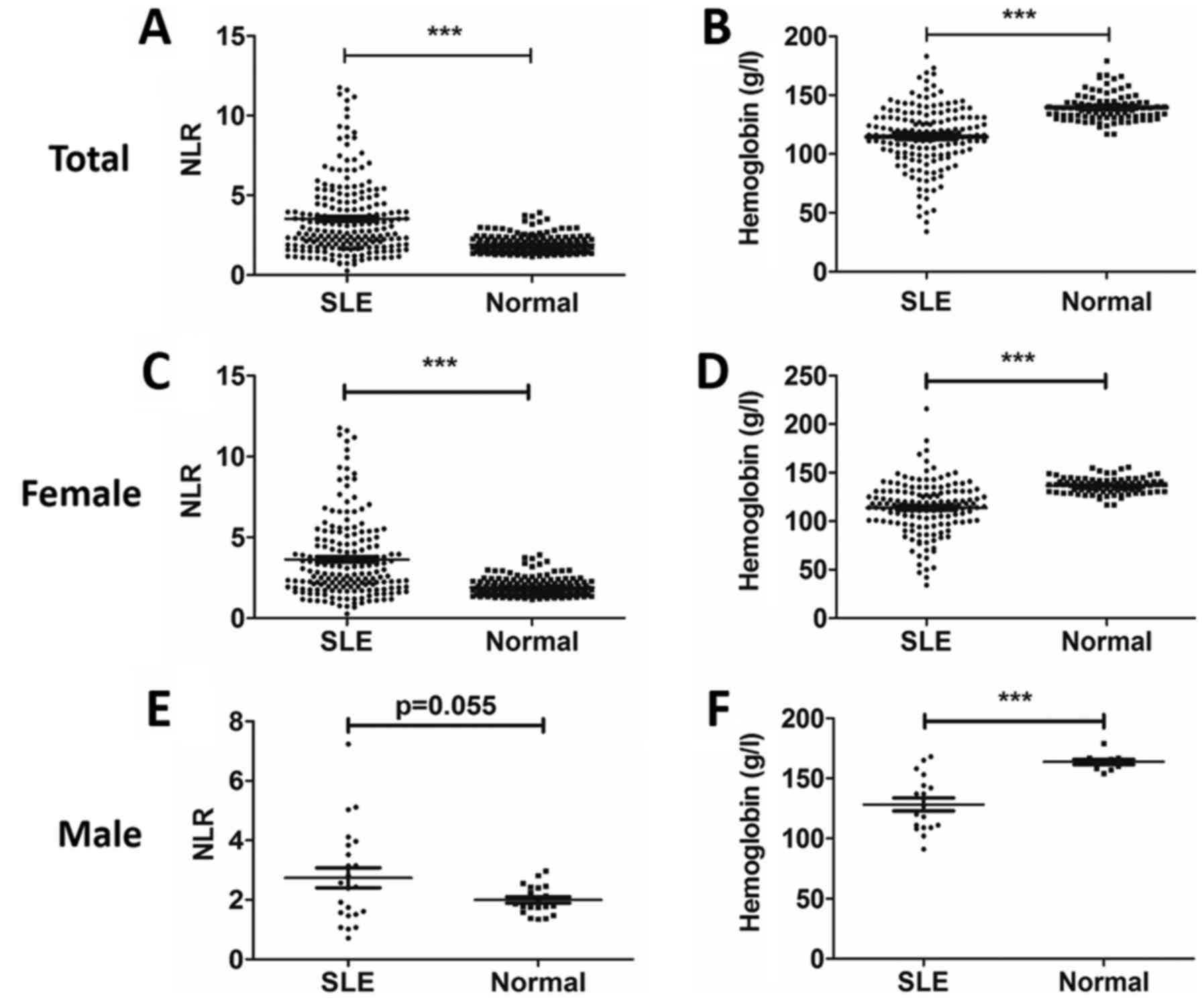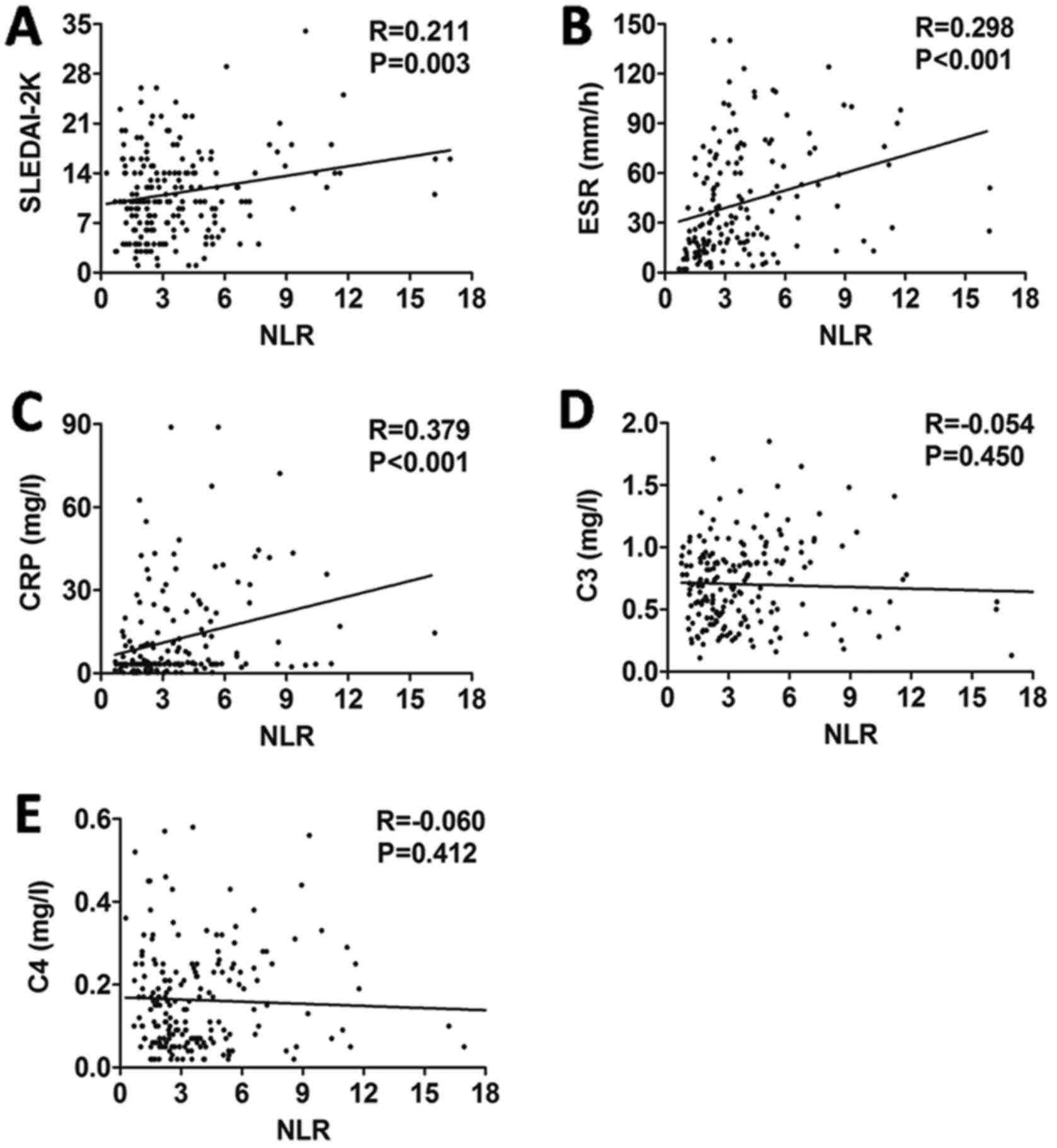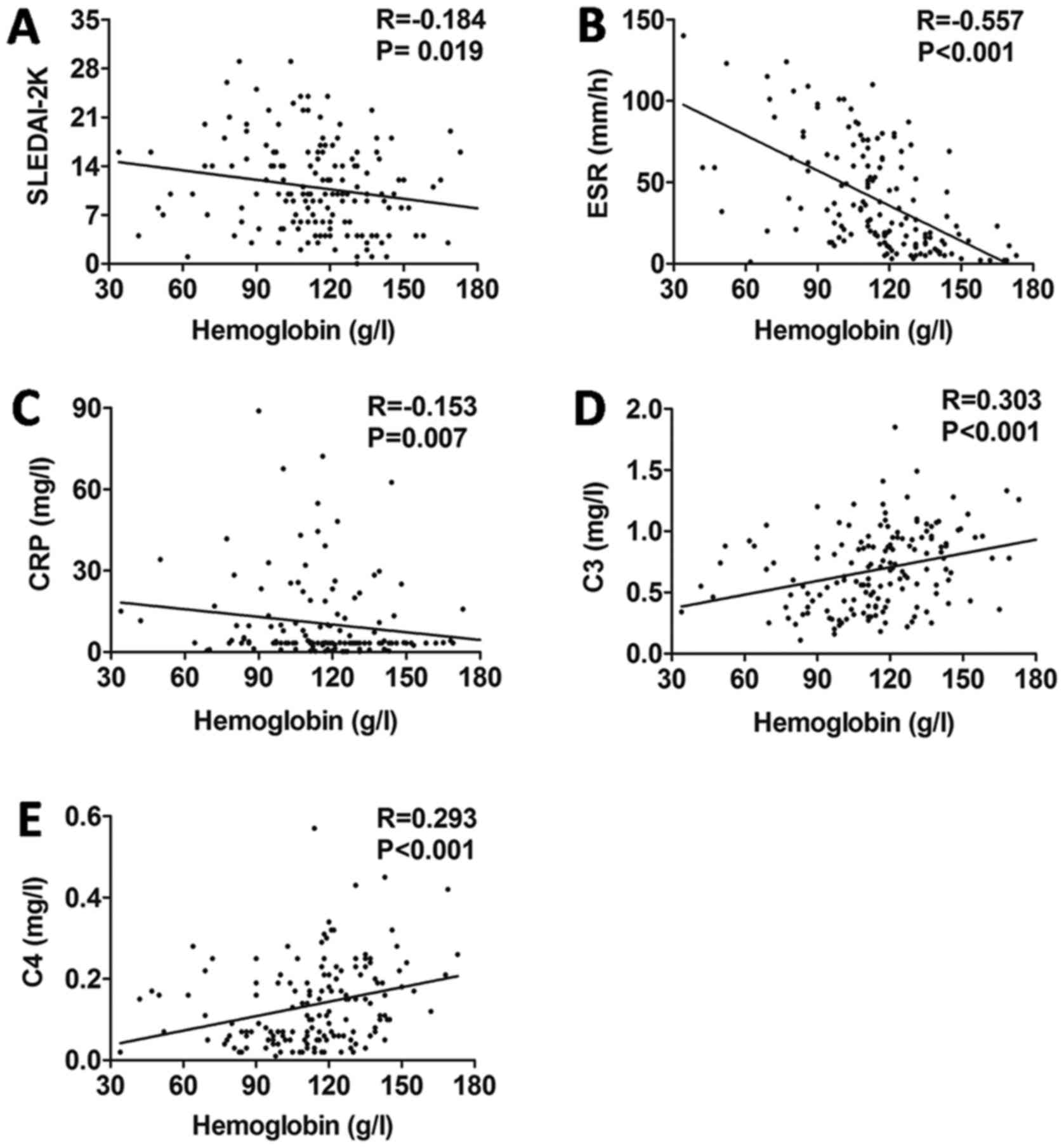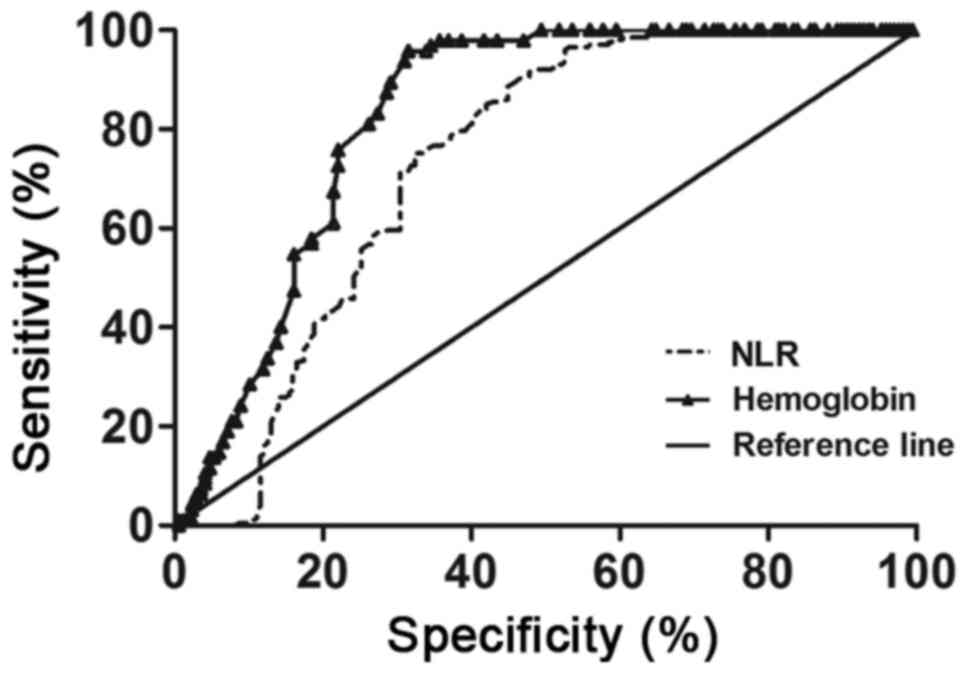|
1
|
Zeng QY, Chen R, Darmawan J, Xiao ZY, Chen
SB, Wigley R, Le Chen S and Zhang NZ: Rheumatic diseases in China.
Arthritis Res Ther. 10:R172008. View
Article : Google Scholar : PubMed/NCBI
|
|
2
|
Liu CC and Ahearn JM: The search for lupus
biomarkers. Best Pract Res Clin Rheumatol. 23:507–523. 2009.
View Article : Google Scholar : PubMed/NCBI
|
|
3
|
Yuan J, Li LI, Wang Z, Song W and Zhang Z:
Dyslipidemia in patients with systemic lupus erythematosus:
Association with disease activity and B-type natriuretic peptide
levels. Biomed Rep. 4:68–72. 2016. View Article : Google Scholar : PubMed/NCBI
|
|
4
|
Urowitz MB, Isenberg DA and Wallace DJ:
Safety and efficacy of hCDR1 (Edratide) in patients with active
systemic lupus erythematosus: Results of phase II study. Lupus Sci
Med. 2:e0001042015. View Article : Google Scholar : PubMed/NCBI
|
|
5
|
Osei-Bimpong A, Meek JH and Lewis SM: ESR
or CRP? A comparison of their clinical utility. Hematology.
12:353–357. 2007. View Article : Google Scholar : PubMed/NCBI
|
|
6
|
Gaitonde S, Samols D and Kushner I:
C-reactive protein and systemic lupus erythematosus. Arthritis
Rheum. 59:1814–1820. 2008. View Article : Google Scholar : PubMed/NCBI
|
|
7
|
Petri M: Disease activity assessment in
SLE: Do we have the right instruments? Ann Rheum Dis. 66 Suppl
3:iii61–iii64. 2007. View Article : Google Scholar : PubMed/NCBI
|
|
8
|
Afari ME and Bhat T: Neutrophil to
lymphocyte ratio (NLR) and cardiovascular diseases: An update.
Expert Rev Cardiovasc Ther. 14:573–577. 2016. View Article : Google Scholar : PubMed/NCBI
|
|
9
|
Balta S, Celik T, Mikhailidis DP, Ozturk
C, Demirkol S, Aparci M and Iyisoy A: The relation between
atherosclerosis and the neutrophil-lymphocyte ratio. Clin Appl
Thromb Hemost. 22:405–411. 2016. View Article : Google Scholar : PubMed/NCBI
|
|
10
|
Kim DS, Shin D, Lee MS, Kim HJ, Kim DY,
Kim SM and Lee MG: Assessments of neutrophil to lymphocyte ratio
and platelet to lymphocyte ratio in Korean patients with psoriasis
vulgaris and psoriatic arthritis. J Dermatol. 43:305–310. 2016.
View Article : Google Scholar : PubMed/NCBI
|
|
11
|
Hu ZD, Sun Y, Guo J, Huang YL, Qin BD, Gao
Q, Qin Q, Deng AM and Zhong RQ: Red blood cell distribution width
and neutrophil/lymphocyte ratio are positively correlated with
disease activity in primary Sjögren's syndrome. Clin Biochem.
47:287–290. 2014. View Article : Google Scholar : PubMed/NCBI
|
|
12
|
Sen BB, Rifaioglu EN, Ekiz O, Inan MU, Sen
T and Sen N: Neutrophil to lymphocyte ratio as a measure of
systemic inflammation in psoriasis. Cutan Ocul Toxicol. 33:223–227.
2014. View Article : Google Scholar : PubMed/NCBI
|
|
13
|
Qin B, Ma N, Tang Q, Wei T, Yang M, Fu H,
Hu Z, Liang Y, Yang Z and Zhong R: Neutrophil to lymphocyte ratio
(NLR) and platelet to lymphocyte ratio (PLR) were useful markers in
assessment of inflammatory response and disease activity in SLE
patients. Mod Rheumatol. 26:372–376. 2016. View Article : Google Scholar : PubMed/NCBI
|
|
14
|
Moller B, Scherer A, Förger F, Villiger PM
and Finckh A: Swiss Clinical Quality Management Program for
Rheumatic Diseases, Anaemia may add information to standardised
disease activity assessment to predict radiographic damage in
rheumatoid arthritis: A prospective cohort study. Ann Rheum Dis.
73:691–696. 2014. View Article : Google Scholar : PubMed/NCBI
|
|
15
|
van Steenbergen HW, van Nies JA and van
der Helm-van Mil AH: Anaemia to predict radiographic progression in
rheumatoid arthritis. Ann Rheum Dis. 72:e162013. View Article : Google Scholar : PubMed/NCBI
|
|
16
|
Smyrnova G: The relationship between
hemoglobin level and disease activity in patients with rheumatoid
arthritis. Rev Bras Reumatol. 54:437–440. 2014.(In Portuguese).
View Article : Google Scholar : PubMed/NCBI
|
|
17
|
Gladman DD, Ibañez D and Urowitz MB:
Systemic lupus erythematosus disease activity index 2000. J
Rheumatol. 29:288–291. 2002.PubMed/NCBI
|
|
18
|
Zahorec R: Ratio of neutrophil to
lymphocyte count-rapid and simple parameter of systemic
inflammation in critically ill. Bratisl Lek Listy. 102:5–14.
2001.(In English, Slovak). PubMed/NCBI
|
|
19
|
Ahsen A, Ulu MS, Yuksel S, Demir K, Uysal
M, Erdogan M and Acarturk G: As a new inflammatory marker for
familial Mediterranean fever: Neutrophil-to-lymphocyte ratio.
Inflammation. 36:1357–1362. 2013. View Article : Google Scholar : PubMed/NCBI
|
|
20
|
Wu Y, Chen Y, Yang X, Chen L and Yang Y:
Neutrophil-to-lymphocyte ratio (NLR) and platelet-to-lymphocyte
ratio (PLR) were associated with disease activity in patients with
systemic lupus erythematosus. Int Immunopharmacol. 36:94–99. 2016.
View Article : Google Scholar : PubMed/NCBI
|
|
21
|
Stohl W, Hiepe F, Latinis KM, Thomas M,
Scheinberg MA, Clarke A, Aranow C, Wellborne FR, Abud-Mendoza C,
Hough DR, et al: Belimumab reduces autoantibodies, normalizes low
complement levels, and reduces select B cell populations in
patients with systemic lupus erythematosus. Arthritis Rheum.
64:2328–2337. 2012. View Article : Google Scholar : PubMed/NCBI
|
|
22
|
Hashimoto M, Fujii T, Hamaguchi M, Furu M,
Ito H, Terao C, Yamamoto K, Yamamoto W, Matsuo T, Mori M, et al:
Increase of hemoglobin levels by anti-IL-6 receptor antibody
(tocilizumab) in rheumatoid arthritis. PLoS One. 9:e982022014.
View Article : Google Scholar : PubMed/NCBI
|
|
23
|
Isaacs JD, Harari O, Kobold U, Lee JS and
Bernasconi C: Effect of tocilizumab on haematological markers
implicates interleukin-6 signalling in the anaemia of rheumatoid
arthritis. Arthritis Res Ther. 15:R2042013. View Article : Google Scholar : PubMed/NCBI
|













